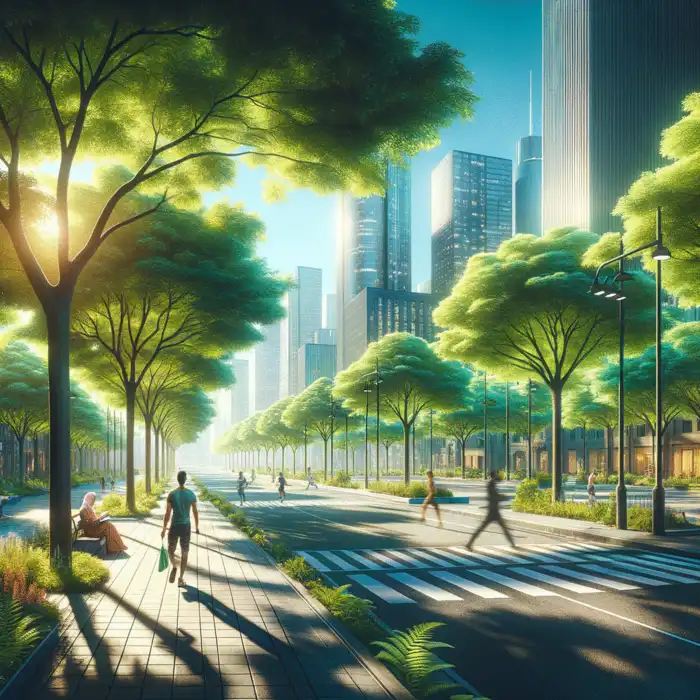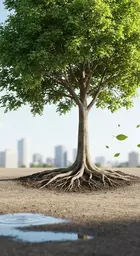Urban Trees Cool City Heat

Posted on: 2025-04-18
By: Keira Vallejo
Urban Heat Islands and the Cooling Power of Urban Trees
Urban heat islands can make city summers unbearable, raising temperatures by up to 10 degrees Fahrenheit compared to surrounding areas. This article highlights the critical role urban trees play in mitigating these effects, offering both environmental and social benefits. Discover how you can contribute to greener, cooler cities!
What You Will Learn
- Urban heat islands can significantly raise city temperatures, highlighting the need for effective cooling solutions.
- Tree canopies can lower surface temperatures by up to 20 degrees, providing essential shade in urban environments.
- Urban trees improve air quality through carbon sequestration, absorbing CO2 and filtering pollutants from the atmosphere.
- Community involvement in tree planting fosters a sense of ownership and can strengthen neighborhood bonds.
- Equitable access to urban greenery is crucial for addressing social and environmental disparities in underserved communities.
- Engaging diverse groups and utilizing data can help ensure that all neighborhoods benefit from urban tree initiatives.
- Investing in urban forestry is vital for creating sustainable, green spaces that benefit future generations.
Impact of Urban Trees on City Temperatures
Urban trees significantly contribute to lowering temperatures, improving air quality, and enhancing urban life quality. The comparison of shaded versus sunny areas illustrates this cooling effect.
Shaded Areas
Tree canopies reduce temperatures significantly.
Sunny Areas
Non-shaded areas retain heat, increasing temperatures.
Carbon Sequestration
Urban trees improve air quality.
Evapotranspiration Process
Moisture release cools surrounding areas.
The Role of Urban Trees in Mitigating City Temperatures
Have you ever stepped outside on a hot day and felt a wave of heat hit you? That’s the urban heat island effect at work! It's essential to understand how urban trees can play a significant role in cooling down our city landscapes and enhancing our quality of life. At Urban Canopy Blog, we’re committed to sharing insights about the incredible benefits trees bring to urban environments.
Understanding Urban Heat Islands and Their Impact
Urban heat islands (UHIs) refer to urban areas that experience higher temperatures than their rural surroundings. This phenomenon primarily occurs due to human activities and the materials used in city infrastructure. Hard surfaces like asphalt, concrete, and buildings absorb and retain heat, leading to warmer air temperatures. In fact, cities can be up to 10 degrees Fahrenheit hotter than nearby rural areas!
Definition and Causes of Urban Heat Islands
As cities continue to expand, urban heat islands become more pronounced. The main causes of UHIs include:
- Increased buildings and roads that absorb heat.
- Limited vegetation, which provides shade and cooling.
- Air pollution from vehicles and factories that trap heat.
Understanding these causes helps us appreciate why urban greenery is so vital in combating heat levels. Trees are more than just beautiful additions; they are essential in restoring balance to our urban ecosystems. Choosing the right trees for your urban space is crucial for maximum impact, and you can learn more about selecting trees for urban spaces here.
Consequences for Urban Communities
The consequences of urban heat islands extend beyond discomfort. They can lead to higher energy costs, increased air conditioning use, and detrimental health effects like heat-related illnesses. Vulnerable populations, such as the elderly and low-income communities, are disproportionately affected. This makes it critical for cities to adopt strategies that integrate greenery, like the tips we share at Urban Canopy Blog.
How Urban Trees Contribute to Temperature Reduction
Urban trees are like nature’s air conditioners! They help lower temperatures in several ways, making our cities more livable and enjoyable. Let’s take a closer look at how they contribute to cooling our surroundings.
The Cooling Effects of Urban Tree Canopies
One of the most significant benefits of urban trees is their ability to provide shade. Tree canopies can reduce surface and air temperatures, leading to a more pleasant outdoor experience. Studies show that shaded areas can be up to 20 degrees cooler than their sunny counterparts. Imagine walking through a park filled with leafy trees on a hot summer day—it’s a refreshing escape!
Insights on Carbon Sequestration and Air Quality Improvement
Urban trees also play a crucial role in improving air quality by absorbing carbon dioxide and releasing oxygen. This process, known as carbon sequestration, helps combat climate change. Moreover, trees filter pollutants from the air, making our cities healthier places to live. They truly are the unsung heroes of urban environments! For more advice on keeping your urban trees healthy and thriving, check out our guide on summer tree care tips for cities.
Evapotranspiration and Shade Provision as Cooling Mechanisms
Another fascinating way trees help cool our cities is through *evapotranspiration*. This is the process by which trees release moisture into the air, which cools the surrounding environment. When combined with the shade they provide, trees are invaluable in moderating urban temperatures. Here’s a quick look at how these mechanisms work:
- Evapotranspiration: Trees absorb water through their roots and release it through leaves.
- Shade Provision: Tree canopies block sunlight, reducing heat absorption by surfaces.
By understanding these processes, we can advocate for more trees in our cities and promote healthier urban spaces. So, next time you see a tree, remember its role in keeping our environment cool and vibrant!
Did You Know?
According to the U.S. Forest Service, urban trees can reduce surrounding air temperatures by as much as 10°F, significantly impacting energy consumption and improving overall urban livability.
Community Involvement and Equity in Urban Tree Planting
Community engagement is a cornerstone of successful urban forestry initiatives. When local residents take part in tree planting, they develop a sense of ownership and responsibility for their green spaces. As someone deeply passionate about urban forestry, I’ve witnessed firsthand how community involvement can turn a simple planting day into a celebration of togetherness and environmental stewardship!
To foster effective community involvement, consider these strategies:
- Host tree planting events to bring neighbors together.
- Collaborate with local schools to educate students about the importance of trees.
- Encourage community members to participate in decision-making processes for tree selection and placement.
- Create volunteer programs that allow residents to care for newly planted trees.
Ensuring Equitable Distribution of Urban Tree Canopy
As we think about planting more trees, it’s crucial to ensure that all neighborhoods benefit from urban greenery. Inequitable access to trees can deepen existing social and environmental disparities. Urban Canopy Blog is committed to highlighting these issues and promoting solutions that ensure everyone enjoys the benefits trees offer. The positive impact of urban trees extends to mental well-being, as discussed in our article on urban trees and mental well-being.
Here’s how we can work towards equitable distribution of the urban tree canopy:
- Prioritize tree planting in underserved areas that lack green spaces.
- Engage with diverse community groups to understand their specific needs.
- Utilize data and mapping tools to identify areas with the least tree coverage.
Environmental Justice and Access to Green Spaces
Environmental justice is about making sure everyone has access to clean air, water, and green spaces. Trees play a pivotal role in this by improving air quality and providing shade, which is especially important in low-income neighborhoods. By planting trees equitably, we can help address environmental injustices that have lingered for far too long. Learn more about the benefits of professional tree care and how it contributes to a healthier urban canopy by visiting our blog post on benefits of professional tree care.
To promote environmental justice in our urban spaces, let’s aim for:
- Developing community gardens that utilize tree planting as a means of greening.
- Advocating for policies that support tree planting in all urban areas.
- Educating communities about the benefits of trees and how they can advocate for more green spaces.
Summary of the Impact of Urban Trees on City Temperatures
In summary, urban trees provide countless benefits that extend beyond just beautifying our streets. They play a vital role in cooling city temperatures, improving air quality, and enhancing our overall well-being. It’s clear that increasing our urban green spaces is not just a nice idea; it’s essential for creating healthier, happier communities.
Encouragement for Action: Investing in Urban Forestry
As we consider the importance of urban trees, I encourage local governments and communities to invest in forestry initiatives. It’s not just about planting trees; it’s about nurturing them, and creating a legacy of green spaces for future generations. Let's take the initiative to make a difference in our cities! For a comprehensive guide on seasonal urban tree care, refer to our detailed seasonal urban tree care guide.
Final Thoughts on Combating Heat Islands Through Green Infrastructure
Combating urban heat islands requires a collective effort, and trees are a powerful part of the solution. By integrating more green infrastructure into our city planning, we can create cooler, more inviting urban environments. So, let’s roll up our sleeves and plant some trees! Remember, every tree counts in this ongoing journey towards greener cities.
Recap of Key Points
Here is a quick recap of the important points discussed in the article:
- Urban heat islands (UHIs) result in cities being significantly warmer than surrounding rural areas, primarily due to human activities and infrastructure.
- Urban trees provide essential cooling benefits by offering shade, improving air quality, and engaging in carbon sequestration.
- Evapotranspiration helps lower temperatures as trees release moisture into the air, complementing the cooling effects of shade provision.
- Community involvement in tree planting fosters a sense of ownership and responsibility, enhancing local green spaces.
- Equitable distribution of urban trees is crucial to ensure all neighborhoods, especially underserved areas, benefit from green spaces.
- Promoting environmental justice through tree planting can help address social and environmental disparities in urban areas.
Frequently Asked Questions
Q: How much can urban trees reduce city temperatures?
A: Studies show that tree canopies can lower surface temperatures by up to 20 degrees Fahrenheit compared to unshaded areas. They also reduce air temperatures significantly.
Q: How do trees improve air quality?
A: Trees absorb carbon dioxide through carbon sequestration and filter pollutants from the air.
Q: Why is community involvement important in tree planting?
A: Community involvement fosters a sense of ownership and responsibility, leading to better care of green spaces.
Q: How can we ensure equitable access to urban trees?
A: We can prioritize tree planting in underserved areas, engage diverse communities, and use data to identify areas needing more trees.
Q: What is evapotranspiration, and how does it impact urban temperatures?
A: Evapotranspiration is the process where trees release moisture into the air, cooling surroundings. This works in conjunction with the shade provided by trees to moderate urban temperatures.
 As urban environments evolve, the resilience of trees becomes increasingly critical in combating cli
As urban environments evolve, the resilience of trees becomes increasingly critical in combating cli
 What if the key to combating urban food insecurity lies in our own backyards? Urban fruit trees not
What if the key to combating urban food insecurity lies in our own backyards? Urban fruit trees not
 Urban environments are often described as concrete jungles, but they can also be vibrant ecosystems
Urban environments are often described as concrete jungles, but they can also be vibrant ecosystems